Students can also read Online Education MCQ Questions for Class 10 Economics Chapter 2 Sectors of Indian Economy Questions with Answers hope will definitely help for your board exams. https://ncertmcq.com/mcq-questions-for-class-10-social-science-with-answers/
Class 10 Social Science Economics Chapter 2 MCQ With Answers
Economics Class 10 Chapter 2 MCQs On Sectors of Indian Economy
Sectors Of Indian Economy Class 10 MCQ Question 1.
Which of the following statements is correct about the GDP?
(a) It shows how big the economy of a country is in terms of purchasing power.
(b) It shows the total product of a country in a given year without calculating the national income.
(c) It shows the number of people involved in production in the tertiary sector in a year.
(d) It shows the value of total goods and services produced in a country in a year.
Answer:
(d) It shows the value of total goods and services produced in a country in a year.
Related Theory
The purchasing power of a country depends upon the value of its currency and the power of its currency to buy commodities.
Class 10 Economics Chapter 2 MCQ With Answers Question 2.
Which organization conducts a survey on employment and unemployment?
(a) NSSO
(b) NREGA
(c) ILO – International Labour Organisation
(d) NITI Aayog
Answer:
(a) NSSO
Explanation: The National Sample Survey Organisation takes a survey every 5 years and data is collated thereafter.
Sector Of Indian Economy Class 10 MCQ Question 3.
Identify which of these is a natural product?
(a) Clothes
(b) A Book
(c) Jute
(d) Apple Juice
Sectors Of Indian Economy MCQ Question 4.
Which of the following examples does not fall under the unorganized sector?
(a) A shoemaker mending shoes.
(b) A daily wage laborer working to build a house.
(c) An HR employee working for a software company.
(d) A cook cooking in the house of her boss.
Answer:
(c) An HR employee working for a software company.
Class 10 Sectors Of Indian Economy MCQ Question 5.
Fill in the blank by choosing the most appropriate option:
…………….. owns the Reliance Industries.
(a) The government
(b) A private business or a group
(c) A Bank
(d) Jointly by private companies and the govt.
Answer:
(b) A private business or a group
![]()
Class 10 Economics Chapter 2 MCQ Question 6.
Fill in the blank by choosing the most appropriate option:
NREGA (National Rural Employment Guarantee Act, 2005) has guaranteed ……………… days of employment in a year in many districts of India.
(a) 365 days
(b) 100 days
(c) 50 days
(d) 180 days
Answer:
(b) 100 days
Sectors Of The Indian Economy Class 10 MCQ Question 7.
…………..is also known as Underemployment.
(a) Disguised Employment
(b) Overemployment
(c) Visible Employment
(d) Extra Employment
Answer:
(a) Disguised Employment
Explanation: Disguised employment is when people having potential to do full time employment are under utilized.
MCQ On Sectors Of Indian Economy Question 8.
Where will you find the disguised unemployment most? Select the correct option from those given below:
(a) Among agricultural workers working on self- owned small farm lands
(b) Factory workers
(c) Private company owners and employees
(d) Government officials
Answer:
(a) Among agricultural workers working on self-owned small farmlands Explanation: Almost all family works on these lands despite their size and this is why the productivity of these workers is less.
Economics Chapter 2 Class 10 MCQ Question 9.
Choose the incorrect pair from the following:
| List I | List II |
| (a) Mailman | Tertiary sector |
| (b) Fisherman | Primary sector |
| (c) Carpenter | Primary sector |
| (d) Banker | Tertiary sector |
Explanation: Carpenter creates furniture out of wood and hence can be classified in the secondary sector. He produces goods by exploiting a natural resource. Both mailman and banking provide services classifying them as tertiary sector employees. Fisherman exploits natural water resources- the fishes and hence are workers of the primary sector.
Answer:
(c) Carpenter – Primary Sector
![]()
Economics Class 10 Chapter 2 MCQ Question 10.
Which is not a characteristic of an unorganized sector?
(a) Small and scattered units which are largely outside the control of the government
(b) Rules and regulations are not followed
(c) Jobs here are high-paid and often regular
(d) No provision for overtime, paid leave, holidays, medical leaves.
Answer:
(c) Jobs here are high-paid and often regular.
MCQ Of Sectors Of Indian Economy Question 11.
MGNREGA 2005 implements the …………… in about 625 districts of India.
(a) Right to Property
(b) Right to Education
(c) Right to Work
(d) Right to Life
Answer:
MCQ Sectors Of Indian Economy Question 12.
Which of the following profession belongs to the Tertiary Sector of the economy?
(a) Fisherman
(b) Farmer
(c) Woodcutter
(d) Teacher
Answer:
(d) Teacher

MCQ Questions For Class 10 Economics Chapter 2 Question 13.
In which sector, do workers enjoy job security?
(a) Agriculture sector
(b) Private-sector
(c) Organised sector
(d) Unorganised sector
Answer:
(c) Organised sector
Explanation: Organised Sector includes industries, shops, factories and businesses registered with the government. They follow labor laws and other rules and regulations laid down by the government. They also provide job security, health care benefits and other incentives to its employees.
Related Theory
Agricultural Sector, Unorganised sector and Private Sector are all unregistered or not backed by the government and hence offer no job security or promise of a dignified life.
![]()
Class 10 Economics Chapter 2 Important MCQ With Answers Question 14.
Which among the following most appropriately describes underemployment?
(a) Workers are not paid as per their work
(b) Workers are working less than what they are capable of doing
(c) Workers are unskilled
(d) Workers are not willing to work
Answer:
(b) Workers are working less than what they are capable of doing
Explanation: When workers are employed in larger numbers than they’re required, their effort becomes divided. This means that here people are apparently working but all of them are made to work less than their true potential, and removing some of them won’t affect production at all. This is underemployment.
Sectors Of Indian Economy MCQs Question 15.
Arrange the following in the correct sequence:
(i) Transporting cloth to the workshops
(ii) Sale in shops and showrooms
(iii) Spinning the yarn
(iv) Weaving of the fabric
Options:
(a) (i)-(iv)-(iii)-(iv)
(b) (iii)-(iv)-(i)-(ii)
(c) (iv)-(i)-(ii)-(iii)
(d) (iii)-(iv)-(ii)-(i)
Identify the following on basis of the hints given in each question.
Question 16.
Identify the sector:
(1) Sector is categorized based on types of activities
(2) Activities that are included in this sector are undertaken by directly using natural resources.
(3) Employed the most number of people in 2000
Answer:
Primary or the Agricultural sector
Question 17.
Identify the sector:
(1) Sector is categorized based on types of activities
(2) Activities which are included in this sector are services offered to professionals
(3) No good is produced
Answer:
Tertiary or the Service Sector
![]()
Question 18.
Identify the sector:
(1) Sector is categorized based on ownership of activities
(2) Private individuals and companies owns most of the assets
(3) Main driving force of this sector is profit.
Answer:
Question 19.
Read the conditions given below and identify in which sector Naresh is working?
| Characteristics | Facilities |
| Job Security | No |
| Medical Facility | No |
| Fixed working Hours | No |
Answer:
Unorganised Sector
Fill in the blanks/tables with suitable information:
Question 20.
When we produce goods by exploiting natural products, it is an activity of the ………….
Question 21.
The …………… sector has become most important in terms of share of the total production in developed countries.
Answer:
Tertiary
Explanation: In case of most developed and developing countries, production in all sectors has grown but tertiary sector has grown the most due to reasons like more development and improvement in Lifestyle. It employs a very large number of people in the world.
Question 22.
In the …………………… sector, the government owns most of the assets and provides all the services.
Answer:
Public
![]()
Question 23.
………….. is an example of an unorganized sector activity.
Answer:
A daily wage labourer working under a contractor
Related Theory
An Unorganised sector is characterised by small and scattered units which are largely outside the control of the government. Rules and regulations are not followed in this sector. There’s absence of labour rules and job security in this sector.
Question 24.
Fill the blanks in table with correct answer:
| Occupations | Sectors |
| Tailor | Tertiary |
| (A)-? | Primary |
| Astronaut | (B)-? |
Answer:
Question 25.
Workers in the ………… sector do not produce goods.
Answer:
Tertiary
Explanation: Workers in Primary and Secondary Sector produce goods while workers in Tertiary sector provide services.
![]()
Match the Columns Choose the correct pairs:
Match the following sectors in Column A with their status given in Column B:
| Column A (Sectors) | Column B (Status) |
| (a) Public sector | (i) Service sector |
| (b) Primary sector | (ii) Regular employment |
| (c) Tertiary sector | (iii) Government owns it |
| (d) Organised sector | (iv) Exploits natural resources |
Answer:
| Column A (Sectors) | Column B (Status) |
| (a) Public sector | (iii) Government owns it |
| (b) Primary sector | (iv) Exploits natural resources |
| (c) Tertiary sector | (i) Service sector |
| (d) Organised sector | (ii) Regular employment |
Question 27.
Match the following occupations in Column A with their sectors in Column B:
| Column A (Occupations) | Column B (Sectors) |
| (a) Bee-keeper | (i) Secondary sector |
| (b) Priest | (ii) Unorganised sector |
| (c) Construction worker | (iii) Primary sector |
| (d) Basket weaver | (iv) Tertiary sector |
Answer:
Assertion Reasoning questions Class 10 Economics Chapter 2
In each of the following questions, a statement of Assertion (A) is given followed by a corresponding statement of Reason (R). Select the correct answer to codes (a), (b) (c) or (d) as given below:
(a) Both (A) and (R) are true and (R) is the correct explanation of (A).
(b) Both (A) and (R) are true but (R) is not the correct explanation of (A).
(c) (A) is correct but (R) is wrong.
(d) (A) is wrong but (R) is correct.
Question 28.
Assertion (A): Not every good or service that is produced and sold needs to be counted to know the total production in each sector.
Reason (R): The value of final goods already includes the value of all the intermediate goods.
Answer:
(a) Both (A) and (R) are true and (R) is the correct explanation of (A).
Question 29.
Assertion (A): GDP (Gross Domestic Product) shows how big the economy is.
Reason (R): GDP of a country is the value of all intermediate goods and services produced within a country during a particular year.
Answer:
(c) (A) is correct but (R) is not correct.
Explanation: GDP is the total sum of the values of all final goods and services produced by all sectors within a country during a particular year. It indicates how developed and successful an economy is.
![]()
Question 30.
Assertion (A): Underemployment can also be called disguised unemployment.
Reason (R): Each person is doing some work but no-one is fully employed according to their true potential. This type of unemployment is hidden unlike the common type of unemployment where the job seeker clearly has no job.
Answer:
(a) Both (A) and (R) are true and (R) is the Correct Explanation of (A).
Question 31.
Assertion (A): The data for India, for the last thirty years, shows that while goods and services produced in the tertiary sector contribute the most to GDP, the highest employment is offered by the primary sector.
Reason (R): Tertiary sector offers limited growth.
Answer:
Question 32.
Assertion (A): Government needs to pay attention to aspects of human development such as availability of safe drinking water, housing facilities for the poor, food and nutrition.
Reason (R): Private Sector cannot offer development.
Answer:
(c) (A) is correct but (R) is wrong.
Explanation: Private sector is based on profit and thus cannot contribute a lot in growth of the people, only the public sector run by the government can fulfill that responsibility.
Question 33.
Assertion (A): The organised sector offers jobs that are the most sought-after.
Reason (R): Because the sector offers high and regular pay.
Answer:
(a) Both (A) and (R) are true and (R) is the correct explanation of (A).
Question 34.
Assertion (A): There is also a need for protection and support of the workers in the unorganized sector.
Reason (R): Workers in an unorganised sector get paid really less and are heavily exploited.
Answer:
(a) Both (A) and (R) are true and (R) is the correct explanation of (A).
Explanation: The workers of the unorganized sector are often exploited and not paid a fair wage. Their earnings are Low and not regular. These jobs are not secure and have no other benefits. They also face social discrimination.
(Competency Based Questions (CBQs))
Question 1.
Read the given source and answer the question that follows:
1/1/hat it means is that there are more people in agriculture than is necessary. So, even if you move a few people out, production will not be affected. In other words, workers in the agricultural sector are underemployed.
Choose one correct statement from the following:
Underemployment occurs:
(a) when people are not willing to work.
(b) when people are working slowly.
(c) when people are working less than what they are capable of doing.
(d) when people are not paid for their jobs.
Answer:
(c) when people are working less than what they are capable of doing.
Explanation: This kind of condition occurs when people work but their efforts get divided. More than the required amount of workers are involved and hence their productivity is reduced.
![]()
Question 2.
Match the items in Column A to the items in Column B.
table-1
(a) (A)-(ll), (B)-(III), (C)-(IV), (D)-(l)
(b) (A)-(lll), (B)-(IV), (C)-(ll), (D)-(l)
(c) (A)-(lll), (B)-(l), (C)-(IV), (D)-(li)
(d) (A)-(l), (B)-(IM), (C)-(ll), (D)-(l)
Answer:
Question 3.
Study the picture given below and identify to what sector does the activity belong to:
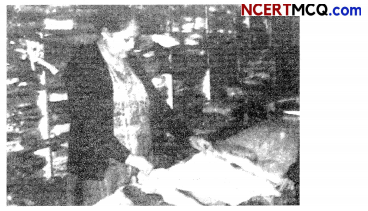
(a) Primary sector
(b) Secondary sector
(c) Tertiary sector
(d) None of these
Answer:
(c) Tertiary Sector
Explanation: A woman can be seen buying clothes from the other. A service is being provided to the customer using already manufactured goods. Such services are classified under Tertiary Sector.
Related Theory
A sector which provide services and support to Primary and Secondary Sector is called as Tertiary Sector.
Question 4.
Observe the picture given below and answer the question that follows.

Which sector does the worker in given cartoon represent?
(a) Primary
(b) Secondary
(c) Tertiary
(d) None
Answer:
(a) Primary
Explanation: The picture is of a farmer. This is a primary sector activity because what she does forms the base for all other products that we subsequently make. Since most of the natural products we get are from agriculture, dairy, fishing, forestry, this sector is also called agriculture and related sector.
Question 5.
Study this picture. Answer the question that follows:
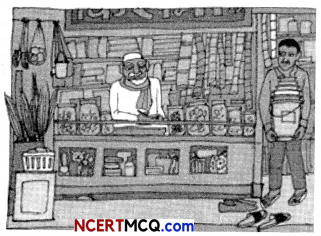
Identify the sector to which the worker in the picture belongs ?
Answer:
Tertiary Sector.
Explanation: Both of these workers provide services while one is a shopkeeper other is a milk seller and sells already manufactured products. They do not produce anything on their own. and hence come under tertiary sector.
Question 6.
Analyse the table given below and answer the question that follows:
This source shows a database of Workers employed in different sectors (in millions)
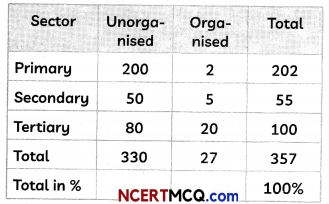
Calculate, the percentage of people in organised sector.
(a) 8.4%
(b) 9.6%
(c) 7.6%
(d) 10%
Answer:
![]()
Question 7.
Read the extract given below and answer the questions that follow:
However, you must remember that not ail of the service sector is growing equally well. Service sector in India employs many different kinds of people. At one end there are a limited number of services that employ highly skilled and educated workers. At the other end, there are a very large number of workers engaged in services such as small shopkeepers, repair persons, transport persons, etc. These people barely manage to earn a living and yet they perform these services because no alternative opportunities for work are available to them. Hence, only a part of this sector is growing in importance. You shall read more about this in the next section.
(A) Which of the following sectors is developing the most?
(a) Primary Sector
(b) Secondary Sector
(c) Tertiary Sector
(d) Organised Sector
Answer:
(c) Tertiary Sector
(B) Why is the Service sector growing unequally?
(a) There are not many types of jobs in Service sector
(b) All jobs offer similar growth but people are unable to utilise it.
(c) All types of jobs are not high paying jobs
(d) Service sector is not growing at all.
Answer:
All types of jobs are not high paying jobs Explanation: Hence some jobs offer higher growth and more offers while others which are not as lucrative do not offer much growth.
(C) What other name is the Service sector also known as?
Answer:
The Tertiary Sector
(D) Assertion (A): Service sector has the largest share among all three sectors but considerable less number of employees.
Reason (R): Service sector is underdeveloped.
(a) Both (A) and (R) are true and (R) is the correct explanation of (A).
(b) Both (A) and (R) are true but (R) is not the correct explanation of (A).
(c) (A) is correct but (R) is wrong.
(d) (A) is wrong but (R) is correct.
Answer:
Question 8.
Read the source given below and answer the questions that follow:
Kanta works in an office. She attends her office from 9.30 a.m. to 5.30 p.m. She gets her salary regularly at the end of every month. In addition to the salary, she also gets provident fund as per the rules laid down by the government. She also gets medical and other allowances. Kanta does not go to the office on Sundays. This is a paid holiday. When she joined work, she was given an appointment letter stating all the terms and conditions of work.
Kamal is Kanta’s neighbour. He is a daily wage labourer in a nearby grocery shop. He goes to the shop at 7:30 in the morning and works till 8:00 p.m. in the evening. He gets no other allowances apart from his wages. He is not paid for the days he does not work. He has therefore no leave or paid holidays.
Answer the following MCQs by choosing the
most appropriate option:
(A) Identify the sector Kanta works in.
(a) Unorganised Sector
(b) Private Sector
(c) Public Sector
(d) Organised Sector
Answer:
(a) She is given Medical Leaves.
(B) Which of the following statements is true about the facilities Kanta is provided at her workplace?
(a) She is given Medical Leaves.
(b) Extra payment for less services.
(c) She can be seasonally removed from her job.
(d) She is not given any paid leaves.
Answer:
(C) Identify the sector Kamal works in:
(a) Private Sector
(b) Unorganised Sector
(c) Public Sector
(d) Organised Sector
Answer:
(b) Unorganised Sector
(D) Which of the following statements is different for Kanta and Kamal?
(a) Fixed Hours at work
(b) Physical employment and activities at work
(c) Allowances and paid leaves
(d) They are exactly the same
Answer:
(c) Allowances and paid leaves

Explanation: Kanta receives her allowances because she works in the organised sector but Kamal does not because he works in a shop which belongs to the unorganised sector.
An online point estimate calculator will allow you to determine the best estimation value of the unknown population parameter with many estimation methods.
![]()
Question 9.
Read the source given below and answer the questions that follow:
Where are most of the people employed? Graph 2 presents the percentage share of the three sectors in GDP. Now you can directly see the changing importance of the sectors over the forty years.
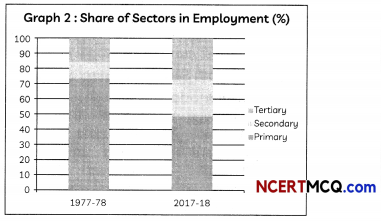
A remarkable fact about India is that while there has been a change in the share of the three sectors in GDP, a similar shift has not taken place in employment. Graph 3 shows the share of employment in the three sectors in 1977-78 and 2017-18. The primary sector continues to be the largest employer even now. Why didn’t a similar shift out of primary sector happen in case of employment? It is because not enough jobs were created in the secondary and tertiary sectors.
Answer the following MCQs by choosing:
(A) Which of the following sectors has the highest share in the GDP?
(a) Primary Sector
(b) Tertiary Sector
(c) Secondary Sector
(d) Both Tertiary and Secondary Sectors are equal in share of the GDP.
Answer:
(b) Tertiary Sector
(B) Which of the following statements is correct about the agricultural sector?
(a) The Agricultural Sector shares the largest contribution in the GDP.
(b) The Agricultural Sector employs the largest number of people in India.
(c) The share of the agricultural sector in the GDP has been rising over years.
(d) The share of the agricultural sector in the GDP has been fixed.
Answer:
(b) The Agricultural Sector employs the largest number of people in India.
(C) What kind of workers are employed in the tertiary sector?
(a) Both Skilled and Semi-Skilled
(b) Unskilled
(c) Only skilled
(d) Only semi-skilled
Answer:
(a) Both Skilled and Semi-Skilled
Explanation: Service sector in India employs many different kinds of people. It employs highly skilled and educated workers and also a number of workers engaged in services such as small shopkeepers, repair persons, transport persons, etc.
(D) Which is the Second largest sector in terms of GDP share?
(a) Primary Sector
(b) Tertiary Sector
(c) Secondary Sector
(d) Both Tertiary and Secondary Sectors are equal in share of the GDP.
Answer:
(c) Secondary Sector
Question 10.
Read the source given below and answer the questions that follow:
For instance, suppose many farmers decide to grow arhar and chickpea (pulse crops). Setting up a dal mill to procure and process these and sell in the cities is one such example. Opening a cold storage could give an opportunity for farmers to store their products like potatoes and onions and sell them when the price is good. In villages near forest areas, we can start honey collection centres where farmers can come and sell wild honey. It is also possible to set up industries that process vegetables and agricultural produce like potato, sweet potato, rice, wheat, tomato, fruits, which can be sold in outside markets. This will provide employment in industries located in semi-rural areas and not necessarily in large urban centres.
Answer the following MCQs by choosing the most appropriate option:
(A) Identify the primary sector activity from the following-
(a) Setting up a Dal Mill
(b) Growing Chickpeas
(c) Setting up Honey Collection centres
(d) Opening a cold storage and letting farmers keep their products here
Answer:
(b) Growing Chickpeas
(B) Identify the secondary sector activity from the following:
(a) Selling vegetables in outside markets
(b) Setting up a Dal Mill
(c) Growing arhar and peas
(d) Transporting bottled honey to city markets
Answer:
(b) Setting up a Dal Mill
(C) Identify the tertiary sector activity from the following:
(a) Setting up a Dal Mill
(b) Growing Chickpeas
(c) Setting up Honey Collection centres
(d) Opening a cold storage and letting farmers keep their products here.
Answer:
(d) Opening a cold storage and charging farmers for storage.
(D) Which sector of activities can be most commonly found in semi-rural areas?
(a) Primary
(b) Secondary
(c) Tertiary
(d) All three are found
Answer:
(a) Primary
Very Short Answer Type Questions
Question 1.
When we produce goods by exploiting natural resources in which category of economic sectors, such activities come?
Answer:
Primary Sector
![]()
Question 2.
In which sector is seasonal and disguised unemployment most prevalent in India?
Answer:
Primary Sector or the Agricultural Sector
Question 3.
Which communities generally find themselves in the unorganised sector?
Answer:
The poorest and most underprivileged communities find themselves in the unorganised sector.
Question 4.
In which sector is manufacturing included?
Answer:
Secondary Sector or the Industry Sector
Question 5.
ATM is an example of which sector?
Answer:
Tertiary Sector
Question 6.
Name the sector which continued to be the largest employer even in the year 2000.
Answer:
Agricultural or the primary sector
Question 7.
Iqbal along with five other members of his family worked as a farmer and produced 50 tons of wheat. Due to some dispute in the family, two members opted out of family business, but still remaining members of the family are able to produce 50 tons of Wheat. Can you name which kind of unemployment the members of the family were facing?
Answer:
Disguised employment.
Explanation: This is because people are employed in a work where their effort gets divided and not much productivity is achieved. They appear employed but they are not employed to their full capacity.
Question 8.
Suggest any one way to generate employment in urban areas.
Answer:
Following are the ways in which employment can be generated in urban areas:
- Improve local and inter-city transportation.
- Increase vocational education courses.
Question 9.
Which category of economic sector does the activity of changing natural products into other forms come under?
Answer:
![]()
Question 10.
How is GDP calculated?
Answer:
GDP in India is calculated by the expenditure method. Only final goods and services are counted to get the finaL value. Therefore, GDP = Value of output – Intermediate consumption.
Question 11.
How is public sector different from the private sector?
Answer:
The public sector is owned, managed and controlled by government whereas the private sector is owned, controlled and managed by individuals or group of individuals.
Question 12.
Why is the tertiary sector becoming an important sector in India? Explain the main reason.
Answer:
Question 13.
Look at the picture given below and identify the sector to which the characters (shown) belong to.
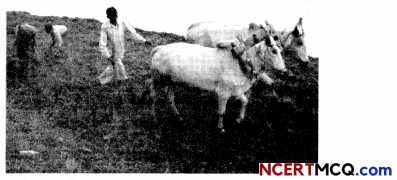
Answer:
The workers shown in the picture are associated with agricultural sector also known as Primary sector.
Explanation: Agriculture and related activities are classified under primary sector activities.
Question 14.
Suggest any one way to increase the income of the marginalised groups in India.
Answer:
Marginal farmers need to be supported through adequate facility for timely delivery of seeds, agricultural inputs, credit, storage facilities and marketing outlets.
![]()
Question 15.
Study the table below and answer the question that follows:
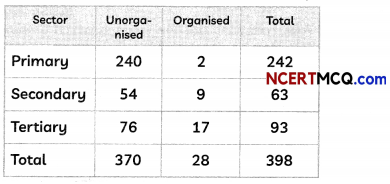
identify the sector that employs largest number of workers?
Answer:
Primary Sector employs the most number of employees including both Organised and Unorganised sectors.
Question 16.
What is GDP?
Answer:
GDP is the value of final goods and services produced in each sector during a particular year.
Question 17.
Identify what sector does these products belong to?
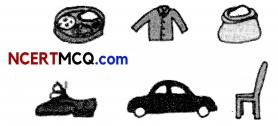
Answer:
These products belong to Secondary Sector. Explanation: All of these products are created by processing products of the primary sector.
For example, clothes are made of cotton which is produced by cultivating its crops, food is prepared by cooking fruits and vegetables. Products which are created by processing primary sector products are classified into secondary sector.
Question 18.
Explain the main advantage of organised sector with respect to employment.
Answer:
In the organised sector, terms of employment are regular and people have assured work throughout the year.
Question 19.
Suggest any one way to create employment in semi-rural areas.
Answer:
By setting up of small and agro-based industries, employment can be created in semi-rural areas.
![]()
Question 20.
The table below shows the estimated number of workers in india in the organised and unorganised sectors. Read the table carefully and answer the question given below:
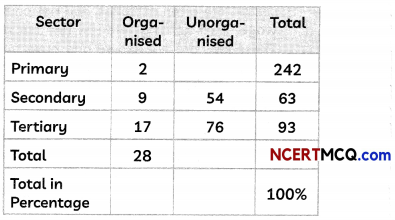
What percentage of tertiary sector workers in india are employed in Unorganised Sector according to the table?
Answer:
Question 21.
In a city, 5000 people work in offices and factories registered with the government, 3000 own offices, clinics in market places with formal license, 7000 people work on street, construction workers and domestic help whereas 9000 people work in small workshops usually not registered with the government. On the basis of the information given above calculate the percentage of people working in the Organised sector and choose the correct option.
(a) 20%
(b) 33%
(c) 50%
(d) 66%
Answer:
(b) 33%
Explanation: Number of People working in the Organised Sector (Companies with formal license of private business with license):
5000 + 3000 = 8000
Number of People working in the Unorganised Sector (Construction Workers, employees in unregistered workshops):
9000 + 7000 = 16000
Sum = 8000 + 16000 = 24000
Percentage of Organised Workers:
= \(\frac{8000}{24000}\) × 100
= 33%
Question 22.
Give one example each of primary and tertiary economic sectors. [CBSE 2019,12]
Answer:
Activities like agriculture, mining, etc. are examples of the primary sector, whereas activities like banking, tourism, etc. are examples of tertiary sector.
Related Theory
The primary sector is the sector of an economy making direct use of‘natural resources’ or relating to primary industries, whereas the tertiary sector helps in the development of the primary and secondary sectors.
![]()
Question 23.
When was MG N REG A passed?
Answer:
MCQ Questions for Class 10 Social Science with Answers
Class 10 Social Science Economics MCQ:
